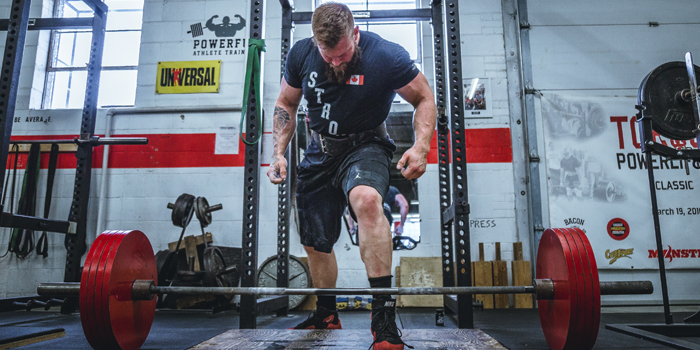
Long gone are the days of the fat powerlifter decreeing that core work consists purely of squat, bench, and deadlift. The acceptance of core stability as a rate limiter or a weak point in powerlifting is as widely accepted now as weak triceps in a bench press or weak glutes in a deadlift.
But when it comes to choosing and executing core stability movements that carry with them the desired dynamic correspondence, we are still behind the times.
RECENT: Why You Should Pull the SSB Handles In While Squatting
The Big Three
The oracle that brought us the importance of core stability training and its implications for pain and performance is none other than Dr. Stuart McGill. His coined “Big Three” exercises are some of the most pivotal interventions when it comes to the world of rehabilitation and injury risk management. Not to be understated in this article is the importance of Dr. McGill’s efforts in this field.
Dr. McGill’s Big Three movements consist of — you guessed it — three exercises. They’re seemingly arbitrary at first glance, but upon closer inspection, you can begin to see the sophisticated genius of Dr. McGill’s now-infamous intervention. The movements are as follows.
1. The Curl-Up
This is the functional antidote for the so commonly administered low back poison that was the conventional sit-up. The Curl-Up, unlike its sit-up counterpart, trains the core’s function to minimize movement through the sagittal plane, whereas the sit-up utilizes the core’s action to actively train flexion and extension of the lumbar spine.
Simply put, the curl-up trains our ability to resist movement from front to back.
2. The Side Plank
The side plank is a clever little exercise with a lot of moving parts — well, actually, this exercise works best when there is as little movement as possible. All wordplay aside, this exercise focuses on primarily utilizing the obliques as they resist force in lateral flexion of the trunk.
Simply put, the side plank trains our ability to resist movement from side to side.
3. The Bird Dog
This quadruped-based exercise is the cornerstone movement of Dr. McGill’s Big Three. With the athlete on all fours, the base of support becomes limited to the opposite hand and the opposite knee. This cross-pattern of stability forces us into stabilization through rotation of the trunk.
Simply put, the bird dog trains our ability to resist movement in rotation.
These three movements were meticulously selected for their cumulative benefit of resisting force in through the lumbar spine through all three planes of movement.
“Central rigidity leads to distal athleticism.” – Dr. Stuart McGill
The Big(gest) Three
With my experience as a clinician, strength coach, and powerlifter, there is one thing that has become abundantly apparent.
RELATED: 3 Things Physical Therapy School Taught Me About Being A Strength Coach
Injuries happen when strength outruns stability.
With that in mind, we have to revisit Dr. McGill’s Big Three and see how we can begin to progress these entry-level stability drills and build off of them to create trunk stability that will scale to heavier loads.
As mentioned in my coaching blog post, “Stability: How to Progress and Regress,” stability is predicated off two components:
- Base of support
- Center of mass
In order to make progressions to Dr. McGill’s Big Three, we need to either limit the base of support of each movement and/or deviate the center of mass.
1. The Ab Wheel
When we look at the Curl-Up exercise, we can identify a broad base of support (athlete is laying on their back) and a minimal deviation of center of mass, making this a very preliminary approach to resisting force through the sagittal plane.
However, when we progress from Curl-Up to Ab Wheel, we minimize the base of support (athlete is supported on their knees), and there is a huge deviation in the center of mass throughout the exercise, all the while resisting force through the sagittal plane.
Simply put, when you perform the ab wheel as a progression to the Curl-Up, you force your core to work a lot harder to resist force and stop the lumbar spine going into extension.
2. Copenhagen Plank
When performing the side plank exercise, the athlete has both feet on the ground, with the foot of the top leg just forward to the foot of the bottom leg. This is an entry-level way to resist lateral flexion through the frontal plane.
However, when we introduce the Copenhagen Plank, we minimize the base of support by only utilizing the foot of the top leg supported on a bench, and this will simultaneously deviate the center of mass.
Simply put, when you perform the Copenhagen Plank, you force the core to work that much harder to stop the lumbar spine going through lateral flexion.
3. Single-Leg Romanian Deadlift
When we take a look at the Bird Dog exercise and its opposite hand, opposite knee setup, it’s clear to see how this is a great exercise to resist rotation through the transverse plane.
WATCH: The Quadruped Row Exercise for Lat Isolation Issues
However, when we introduce the Single-Leg Romanian Deadlift, we go from having a broad base of support with hand and knee on the ground in the Bird Dog to just supporting on one foot only. Standing rather than starting in the kneeling position will immediately deviate the center of mass.
Simply put, when you perform the Single-Leg Romanian Deadlift, you for the core to work that much harder to stop the lumbar spine going through rotation.
Conclusion
As athletes, we're always looking for new ways to gain strength: Eccentrics, isometrics, specialty bars, training blocks, diets, pills, powders, and shakes, but sometimes our blind spot is right in front of us.
It’s time we start taking stability seriously, and scaling this as a separate stimulus will unlock our output and allow us to start putting more weight on the bar.
Stay strong,
Dr. Jordan Shallow, D.C.











Would a suitcase carry fit the bill in the same spot as the side plank and the Copenhagen plank ?
If not, would you mind explaining why ?
Thanks in advance
Simon